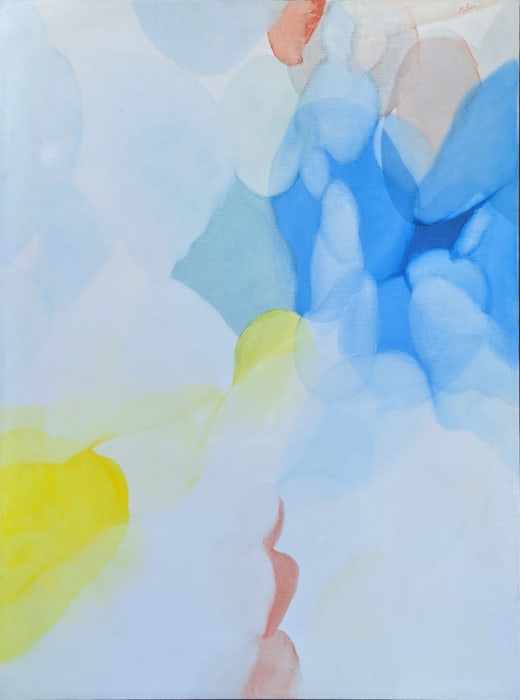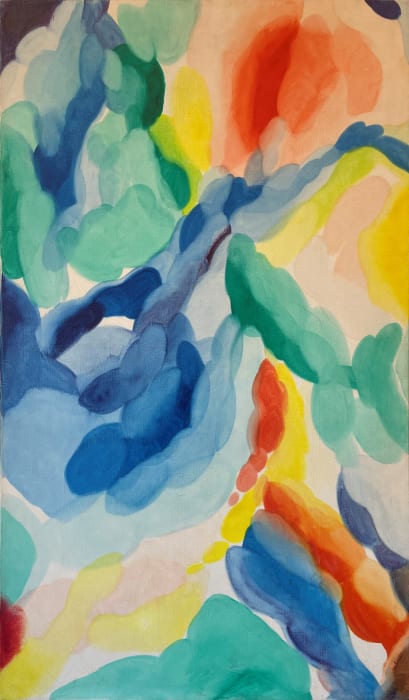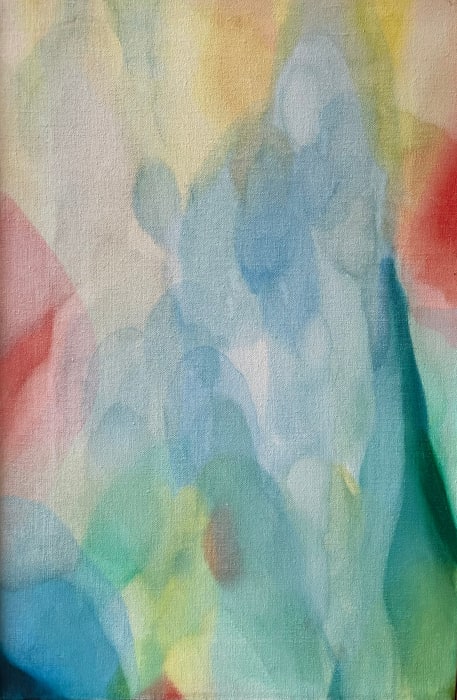Alice Baber once famously described her intent as looking for a “way to get the light moving across the whole thing.” To a large degree, she succeeded. Light streams across her paintings, seemingly from different directions at once, while her cloud-like shapes appear to float across the canvas. The mass of delicate shapes and soft colors not only overlap but almost seem to extend beyond the painting and wash over the viewer. To view a Baber painting is to luxuriate in the sheer joy of color.
Alice Baber was born in Charleston, IL, the younger of two sisters. She studied art for two years at Lindenwood College for Women in St. Charles, MO and then transferred to Indiana University in Bloomington. At Indiana, she worked with Alton Pickens, a well-known figurative painter. She received her MA in 1951, traveled briefly in Europe, and then moved to New York City, the capital of abstract expressionism.
“My intention from the very beginning,” she explained in 1973, “was to try to find a way that didn't remind me of a thousand other people that I had seen.” In the 1960s, she began to explore the possibilities of color and light by using elongated circles. She preferred ovoid shapes because she thought they conveyed the greatest sense of motion across the canvas.
Baber constructed her compositions very carefully. To achieve her luminous effects, she applied transparent layers of diluted oil or acrylic paint to her primed canvases. Baber liked to apply the paint with linen rags wrapped around her hand or finger to achieve her desired intensity of color. Sometimes she used a turpentine-soaked rag to ‘lift’ areas of color and change the opacity of the shapes.
Although color, shape, and light were crucial to Baber’s work, she also emphasized the interplay between positive and negative space. “I often paint a painting until it tells me to stop, and sometimes the white ground still shows,” she once said. “In most cases, I try to make the white ground either a pattern, so that it can be both negative and positive space, or if not that, perhaps an atmospheric wind moving the other colors and shapes around.”
Baber resisted the idea of applying some cosmic meaning to her painting. “I feel that an abstract painting is outer space,” she once said, “and I am in front of it, suspended in outer space, so that there isn't any horizon line. However, there is probably a sense of up and down, and side to side.” Beyond that, she left room for each viewer to find his or her own interpretation of her art. “I want the viewer to create part of the meaning,” she declared.
Baber loved to travel. In the 1950s, she would spend half the year in Paris, and then lived in that city from 1959 to 1968. She also visited Japan, India, Iran, and many Latin American countries. She finally made New York her base around 1968 just before her marriage to the color-field painter Paul Jenkins ended in divorce.
In the 1970, Baber helped to organize, curate, and promote exhibitions of women artists. She also taught and lectured at a wide variety of institutions including C. W. Post College [Queens], SUNY Purchase, and the Universities of Minnesota and California. She died of cancer at 54 years old
The undulating shapes of Alice Baber’s paintings seem to vibrate with radiant color, what she once called “the whole idea of colored wind moving across the canvas.” Her canvases remain classics of second-generation color-field painting.






